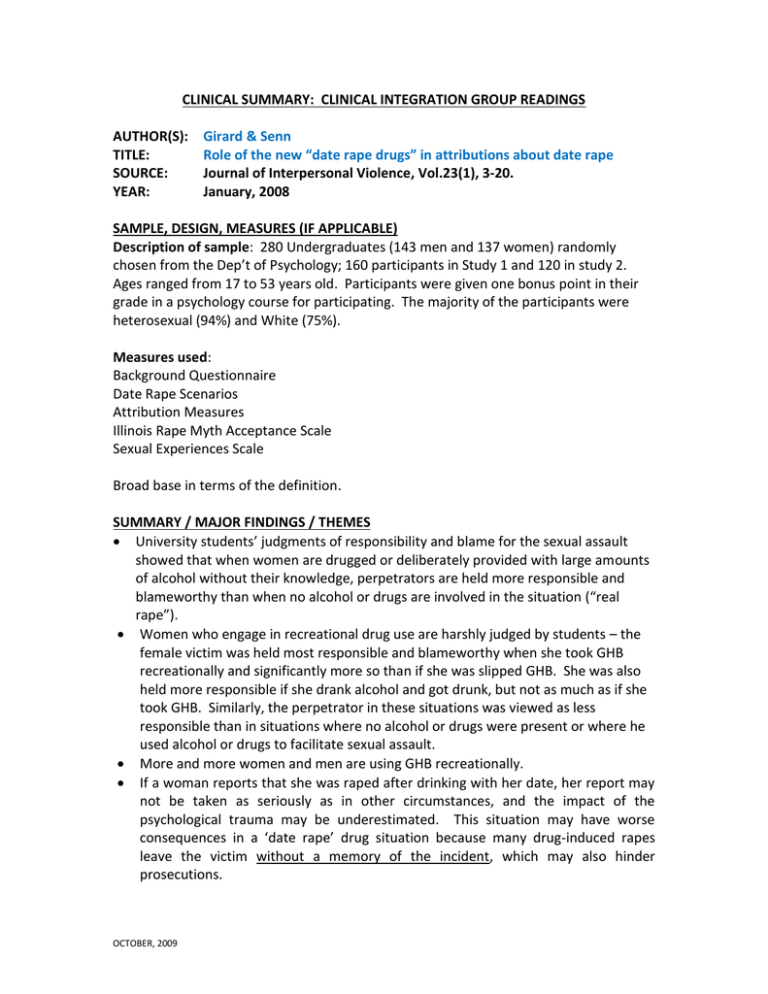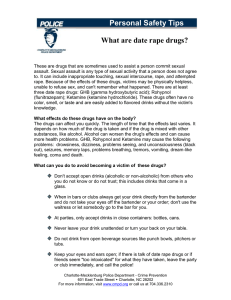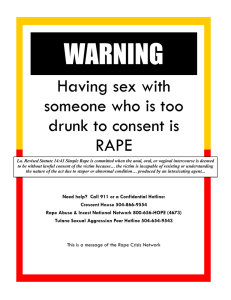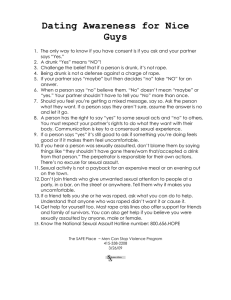
CLINICAL SUMMARY: CLINICAL INTEGRATION GROUP READINGS
AUTHOR(S):
TITLE:
SOURCE:
YEAR:
Girard & Senn
Role of the new “date rape drugs” in attributions about date rape
Journal of Interpersonal Violence, Vol.23(1), 3-20.
January, 2008
SAMPLE, DESIGN, MEASURES (IF APPLICABLE)
Description of sample: 280 Undergraduates (143 men and 137 women) randomly
chosen from the Dep’t of Psychology; 160 participants in Study 1 and 120 in study 2.
Ages ranged from 17 to 53 years old. Participants were given one bonus point in their
grade in a psychology course for participating. The majority of the participants were
heterosexual (94%) and White (75%).
Measures used:
Background Questionnaire
Date Rape Scenarios
Attribution Measures
Illinois Rape Myth Acceptance Scale
Sexual Experiences Scale
Broad base in terms of the definition.
SUMMARY / MAJOR FINDINGS / THEMES
University students’ judgments of responsibility and blame for the sexual assault
showed that when women are drugged or deliberately provided with large amounts
of alcohol without their knowledge, perpetrators are held more responsible and
blameworthy than when no alcohol or drugs are involved in the situation (“real
rape”).
Women who engage in recreational drug use are harshly judged by students – the
female victim was held most responsible and blameworthy when she took GHB
recreationally and significantly more so than if she was slipped GHB. She was also
held more responsible if she drank alcohol and got drunk, but not as much as if she
took GHB. Similarly, the perpetrator in these situations was viewed as less
responsible than in situations where no alcohol or drugs were present or where he
used alcohol or drugs to facilitate sexual assault.
More and more women and men are using GHB recreationally.
If a woman reports that she was raped after drinking with her date, her report may
not be taken as seriously as in other circumstances, and the impact of the
psychological trauma may be underestimated. This situation may have worse
consequences in a ‘date rape’ drug situation because many drug-induced rapes
leave the victim without a memory of the incident, which may also hinder
prosecutions.
OCTOBER, 2009
Rape-myth beliefs (i.e. belief that women control sexual interactions and are at
some level responsible for a sexual situation) is common in North American society,
especially by men – socialization.
North Americans tend to perceive date rape as more permissible than stranger rape
– in fact, the greater the acquaintanceship between a man and woman, the less
likely people are to judge an instance of forced sexual contact.
CLINICAL IMPLICATIONS / RELEVANCE TO PRACTICE
The findings suggest that individuals may be more punitive to offenders and blame
victims less in sexual assaults where drugging (whether drugs or alcohol) is used as
a weapon than where both the victim and the perpetrator have been drinking.
When used voluntarily by women, drugs - perhaps even to a greater extent than
alcohol - seriously decreases their worthiness as a ‘victim’ (ie they are not believed
as much).
When a woman cannot remember the incident, this can have a negative impact on
how others view the assault.
There is evidence that GHB and other drugs are taken quite routinely.
In this small group 7% of the women reported engaging in sex against their will due
to men giving them drugs or alcohol; 3% of men admitted to doing this – % could be
higher as women suspect rape but can’t remember details due to possibility of
having been drugged.
Victim blaming is clearly an obstacle to effective treatment for victims, legal action
against perpetrators and the search for justice.
Our female adolescent clients need to be educated re: above issues – they are an
especially vulnerable group given the trauma in their lives, low self-esteem and
need to belong.
STRENGTHS AND LIMITATIONS OF THE STUDY/READING
Heterogeneous sample: White, heterosexual, psychology undergraduates. This would
need to be studied further with a more diverse sample.
OCTOBER, 2009





